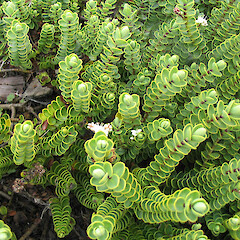Veronica dilatata
Synonyms
Hebe dilatata G.Simpson et J.S.Thomson, Hebe crawii Heads
Family
Plantaginaceae
Flora category
Vascular – Native
Endemic taxon
Yes
Endemic genus
No
Endemic family
No
Structural class
Trees & Shrubs - Dicotyledons
Chromosome number
2n = 120
Current conservation status
The conservation status of all known New Zealand vascular plant taxa at the rank of species and below were reassessed in 2017 using the New Zealand Threat Classification System (NZTCS) – more information about this can be found on the NZTCS website. This report includes a statistical summary and brief notes on changes since 2012 and replaces all previous NZTCS lists for vascular plants.
Please note, threat classifications are often suggested by authors when publications fall between NZTCS assessment periods – an interim threat classification status has not been assessed by the NZTCS panel.
- Conservation status of New Zealand indigenous vascular plants, 2017 . 2018. Peter J. de Lange, Jeremy R. Rolfe, John W. Barkla, Shannel P. Courtney, Paul D. Champion, Leon R. Perrie, Sarah M. Beadel, Kerry A. Ford, Ilse Breitwieser, Ines Schönberger, Rowan Hindmarsh-Walls, Peter B. Heenan and Kate Ladley. Department of Conservation. Source: NZTCS and licensed by DOC for reuse under the Creative Commons Attribution 4.0 International licence.
2017 | At Risk – Naturally Uncommon | Qualifiers: Sp
Previous conservation statuses
2012 | At Risk – Naturally Uncommon | Qualifiers: Sp
2009 | At Risk – Naturally Uncommon
2004 | Sparse
Brief description
Low growing sprawling blueish-green shrub forming patches to several metres wide inhabiting mountains of northern Southland and the Takitimu. Twigs erect, reddish. Leaves dished, oval, with pointed tip. Leaf bud with small gap between base of leaves. Flowers in spike to 4cm long, sometimes branched.
Distribution
Endemic. South Island, confined to the southern South Island where it is locally known from the Umbrella, Garvie, Eyre and Takitimu ranges. It has also been recorded once from the Blue Mountains near Tapanui.
Habitat
A species of alpine habitats (usually > 1000 m a.s.l.) whch is usually found in rocky ground, in and around boulders, at the toe of scree slopes or in adjoining tussock grassland, seepages and bogs.
Detailed description
Spreading (either openly, densely or even mat-like) low or erect shrub up to 0.4 m tall. Branches decumbent to suberect, old stems dark brown to black; branchlets green, red or brown, bifariously pubescent; internodes 1-18 mm, leaf scars evident. Leaf bud distinct; sinus small and narrowly acute. Petiole 0.5-4 mm, hairy. Leaves 4-25 x 4-11 mm, glossy or dull green to glaucescent on both surfaces, obovate, spathulate or elliptic, coriaceous, concave, erect to recurved, arranged decussately or somewhat distichously; apex obtuse to rounded. Inflorescences with 5-52 flowers, lateral unbranched or tripartite (when unbranched with lowermost bracts enlarged and sterile); 5-42 mm, usually longer than or equal to subtending leaves. Peduncle 10-90 mm; rachis 5-23 mm. Flowers gynodioecious. Pedicels 0.5-2 mm, calyx 2.4-3.8 mm, 3-5-lobed, with anterior lobes united from one third to all the way to apex; lobes ovate, subacute, obtuse, or emarginate. Corolla tube 1.2-2.5 x 1.8-2.5 mm, funnelform, glabrous.. Stamen filaments 3.8-4.2 mm, anthers magenta 1.9-2.2. mm. Ovary 0.7-1.5 mm; style 3.4-4.2 mm. Capsules 3.4-4.5 x 2.1-2.8 mm, obtuse to subacute, glabrescent. Seeds 0.9-1.1 x 0.6-1 mm, straw-yellow to pale brown, broad ovoid to sub-discoid.
Similar taxa
A very distinctive species whose closest relative seems to be Veronica societatis, which is a northern South Island species known at present from just one site on Mt Murchison above the Buller River. It is a sparingly branched, whip-like shrub with a rather different chromosome number (2n = 42 cf. 2n = 120). In the field it could be confused with V. cockayneana. Veronica cockayneana differs from V. dilatata by its usually more erect bushy habit, and leaves which are glossy above and glaucous below. The inflorescences of V. dilatata differ in that they are all usually branched (with at least 1-2 branches near the base), or if unbranched, the basal bracts are rather more conspicuous than usual and sterile. Within V. dilatata a distinctive, more upright bushy form from the Takitimu Range has been separated as Hebe crawii Heads, mainly due to its erect habit and usually tripartite inflorescences. It is now included within the normal range of variation exhibited by V. dilatata but many botanists still prefer to regard it as a distinct species.
Flowering
November - March
Flower colours
Violet/Purple, White
Fruiting
November - April
Life cycle
Seeds are wind dispersed (Thorsen et al., 2009).
Propagation technique
Easily grown from semi-hardwood cuttings and layered, rooted pieces. Fresh seed (as in most hebes) probably germinates well. An excellent plant for a sunny, open spot in a rock garden or in a tub/planter on a patio. As a high alpine it rarely flowers in the northern part of New Zealand. Nevertheless it has an attractive form and should be more widely grown.
Threats
A naturally uncommon, wide ranging species which is never very common at any particular place.
Etymology
veronica: Named after Saint Veronica, who gave Jesus her veil to wipe his brow as he carried the cross through Jerusalem, perhaps because the common name of this plant is ‘speedwell’. The name Veronica is often believed to derive from the Latin vera ‘truth’ and iconica ‘image’, but it is actually derived from the Macedonian name Berenice which means ‘bearer of victory’.
dilatata: Expanded
Where To Buy
Not commercially available.
Attribution
Fact Sheet Prepared by P.J. de Lange (1 November 2009). Description based on Bayly & Kellow (2006)
References and further reading
Bayly M.; Kellow A. 2006: An Illustrated Guide to New Zealand Hebes.Te Papa Press: Wellington
Thorsen, M. J.; Dickinson, K. J. M.; Seddon, P. J. 2009. Seed dispersal systems in the New Zealand flora. Perspectives in Plant Ecology, Evolution and Systematics 11: 285-309
NZPCN Fact Sheet citation
Please cite as: de Lange, P.J. (Year at time of access): Veronica dilatata Fact Sheet (content continuously updated). New Zealand Plant Conservation Network. https://www.nzpcn.org.nz/flora/species/veronica-dilatata/ (Date website was queried)





